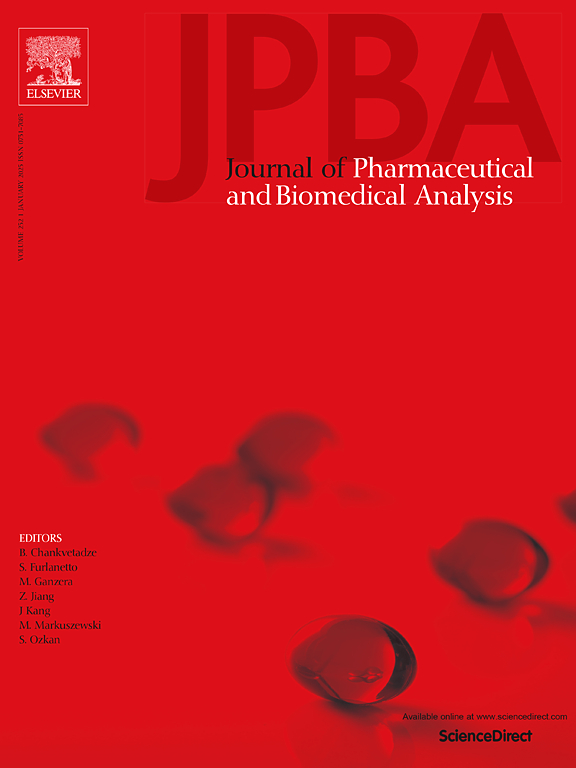Integrated network pharmacology and RNA sequencing analysis to reveal the mechanisms of Qici Sanling decoction in the treatment of gemcitabine resistant bladder cancer
IF 3.1
3区 医学
Q2 CHEMISTRY, ANALYTICAL
Journal of pharmaceutical and biomedical analysis
Pub Date : 2025-04-10
DOI:10.1016/j.jpba.2025.116885
引用次数: 0
Abstract
Bladder cancer (BCa) is the most prevalent cancer of the urinary system in adults; the prognosis is dismal for BCa treated with gemcitabine (GEM) owing to intrinsic or acquired chemoresistance. This study investigated the potential of Qici Sanling decoction (QCSL), an herbal Chinese medicine, to augment the efficacy of GEM in treating GEM-resistant BCa via network pharmacology and RNA sequencing. We screened 103 active components of QCSL and their 226 targets from the TCMSP database and identified 3985 targets of GEM-resistant BCa via transcriptome sequencing. On the basis of the 69 common targets, a protein![]() protein interaction (PPI) network was constructed to identify the top 7 targets. Disease Ontology (DO), Gene Ontology (GO), and Kyoto Encyclopedia of Genes and Genomes (KEGG) functional enrichment analyses were conducted to uncover key pathways. CCK-8 assays, Western blotting, flow cytometry, colony formation, and EdU assays were used to assess the apoptosis and proliferation of GEM-resistant T24 and J82 cells treated with QCSL. The BCa gene set was among the top enriched gene sets in the DO analysis; GO analysis revealed enrichment of 2020 terms linked to GEM resistance, and KEGG analysis revealed 161 enriched signalling pathways. Molecular docking indicated that PTGS2 has high affinity for targets of QCSL components. In vitro experiments demonstrated that cells treated with both QCSL and GEM had significantly reduced viability, increased levels of apoptosis, and decreased proliferative capacity. Thus, QCSL enhances the therapeutic effects of GEM in BCa by promoting cell apoptosis and inhibiting cell proliferation. These findings have significant clinical implications, highlighting a potential combined treatment strategy for GEM-resistant BCa to improve patient outcomes.
protein interaction (PPI) network was constructed to identify the top 7 targets. Disease Ontology (DO), Gene Ontology (GO), and Kyoto Encyclopedia of Genes and Genomes (KEGG) functional enrichment analyses were conducted to uncover key pathways. CCK-8 assays, Western blotting, flow cytometry, colony formation, and EdU assays were used to assess the apoptosis and proliferation of GEM-resistant T24 and J82 cells treated with QCSL. The BCa gene set was among the top enriched gene sets in the DO analysis; GO analysis revealed enrichment of 2020 terms linked to GEM resistance, and KEGG analysis revealed 161 enriched signalling pathways. Molecular docking indicated that PTGS2 has high affinity for targets of QCSL components. In vitro experiments demonstrated that cells treated with both QCSL and GEM had significantly reduced viability, increased levels of apoptosis, and decreased proliferative capacity. Thus, QCSL enhances the therapeutic effects of GEM in BCa by promoting cell apoptosis and inhibiting cell proliferation. These findings have significant clinical implications, highlighting a potential combined treatment strategy for GEM-resistant BCa to improve patient outcomes.
结合网络药理学和RNA测序分析,揭示七次三灵汤治疗吉西他滨耐药膀胱癌的机制
膀胱癌(BCa)是成人泌尿系统最常见的癌症;吉西他滨(GEM)治疗BCa由于内在或获得性化疗耐药,预后不佳。本研究通过网络药理学和RNA测序技术,探讨中药七次三灵汤(QCSL)增强GEM治疗GEM耐药BCa疗效的潜力。我们从TCMSP数据库中筛选出QCSL的103个活性成分及其226个靶点,并通过转录组测序鉴定出3985个抗gem BCa靶点。在69个常见靶点的基础上,构建蛋白-蛋白相互作用(PPI)网络,鉴定出排名前7位的靶点。通过疾病本体(DO)、基因本体(GO)和京都基因与基因组百科全书(KEGG)功能富集分析来揭示关键途径。采用CCK-8法、Western blotting法、流式细胞术、集落形成法和EdU法检测QCSL处理后抗gem T24和J82细胞的凋亡和增殖情况。在DO分析中,BCa基因集是富集程度最高的基因集;GO分析显示与GEM抗性相关的2020个术语富集,KEGG分析显示161个富集的信号通路。分子对接表明PTGS2对QCSL组分的靶点具有较高的亲和力。体外实验表明,QCSL和GEM均能显著降低细胞活力,增加细胞凋亡水平,降低细胞增殖能力。因此,QCSL通过促进细胞凋亡和抑制细胞增殖来增强GEM对BCa的治疗作用。这些发现具有重要的临床意义,强调了gem耐药BCa的潜在联合治疗策略,以改善患者的预后。
本文章由计算机程序翻译,如有差异,请以英文原文为准。
求助全文
约1分钟内获得全文
求助全文
来源期刊
CiteScore
6.70
自引率
5.90%
发文量
588
审稿时长
37 days
期刊介绍:
This journal is an international medium directed towards the needs of academic, clinical, government and industrial analysis by publishing original research reports and critical reviews on pharmaceutical and biomedical analysis. It covers the interdisciplinary aspects of analysis in the pharmaceutical, biomedical and clinical sciences, including developments in analytical methodology, instrumentation, computation and interpretation. Submissions on novel applications focusing on drug purity and stability studies, pharmacokinetics, therapeutic monitoring, metabolic profiling; drug-related aspects of analytical biochemistry and forensic toxicology; quality assurance in the pharmaceutical industry are also welcome.
Studies from areas of well established and poorly selective methods, such as UV-VIS spectrophotometry (including derivative and multi-wavelength measurements), basic electroanalytical (potentiometric, polarographic and voltammetric) methods, fluorimetry, flow-injection analysis, etc. are accepted for publication in exceptional cases only, if a unique and substantial advantage over presently known systems is demonstrated. The same applies to the assay of simple drug formulations by any kind of methods and the determination of drugs in biological samples based merely on spiked samples. Drug purity/stability studies should contain information on the structure elucidation of the impurities/degradants.

 求助内容:
求助内容: 应助结果提醒方式:
应助结果提醒方式:


